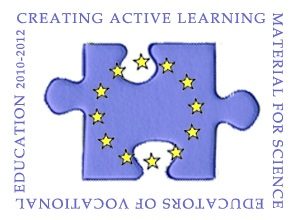Lifelong Learning Program Leonardo Da Vinci: LEO04 «CREATING ACTIVE LEARNING MATERIAL FOR SCIENCE EDUCATORS OF VOCATIONAL EDUCATION»
Extensive research has shown that teaching science using traditional methods is not an effective way to do so today. However, it is quite difficult to create the right conditions for an active learning process while students, teachers, and school boards are accustomed to traditional methods. For this reason, this project was developed by nine different institutions across Europe.
Traditional methods, where teachers transfer information based on one-way communication, center the teacher. Modern teaching methods, now called active teaching, focus on students as part of the learning process. Today, all countries are busy transforming their education systems into active learning or are already busy making changes to them. It is a truly difficult process for school boards, teachers, and students to implement this into their teaching methods. Because of this, sharing students’ and teachers’ experiences with the techniques and methods of science and technology is considered a secondary focus. As we succeed in this, students in other partner countries will also gain information about different techniques and methods.
During the project, the following objectives were investigated:
- Share experience with active learning materials used by educators.
- To analyze, collect and provide outdoor educational material.
- Gather and describe learning material based on scientific research.
- Collect and describe science-based information communication technologies (ICTs) related to vocational learning materials.
- Provide detailed practical examples (as an educational path) of learning materials and exercises that allow for improving critical and creative thinking skills in education.
- To discover the strengths and weaknesses of different science learning materials.
- To produce a website, which will be used as an e-advisor and guide for people interested in the professional development of science teachers.
- Students and academic staff will share their experiences of active and participatory learning, apply their methods in institutions in other countries, and compare learning behaviors.
- Sharing new, trending active learning science materials among participating countries.
- To enhance science teachers’ knowledge and skills in using active learning materials in their professional development.
- Allow boards of teacher education institutions to create an active learning environment in their institution.
- Improve the teaching skills and knowledge of academic staff by sharing professional experience.

